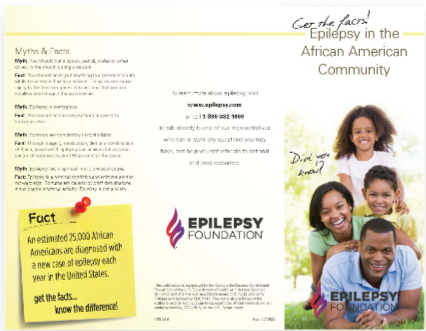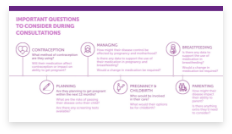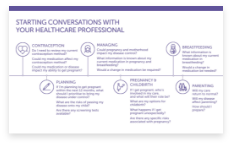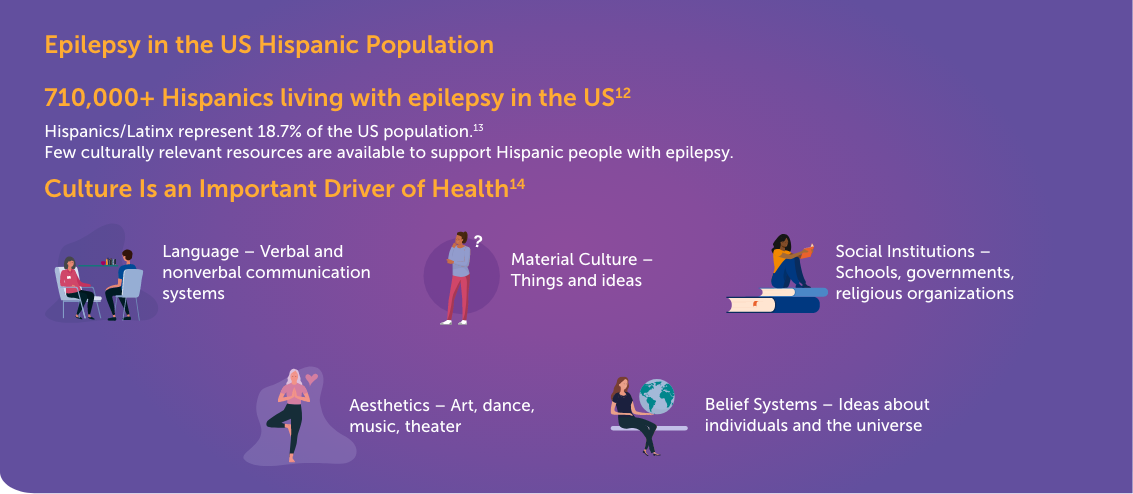Epilepsy in Different Types of People
Epilepsy affects people in different ways at different times of their lives. It’s important to know what others experience to prepare yourself for life events.
Children, teenagers, adults, and older adults may all face different problems in managing their epilepsy.

SHARE
Quick Facts About People With Epilepsy
Epilepsy
affects
Women Men Children LGBTQIA+ All ages All races and ethnic backgrounds
People are most likely to be diagnosed with epilepsy as a child or older adult
Number of People Diagnosed With Epilepsy
Number of new epilepsy cases for each age group is out of 100,000 people
Around 50 million to 65 million people around the world have epilepsy
In the US epilepsy is the 4th most common neurological disorder
Over 150,000 people are diagnosed with epilepsy each year
About 3.4 million people in the US have epilepsy (approximately 1.2% of the US population)
This means 1in 26 people in the US may develop epilepsy at some point in their lifetime
Epilepsy in different types of people
For many women of childbearing age who are living with a chronic disease, reproductive health is often not the focus of discussions with healthcare professionals. Although pregnancy may not be an immediate priority, information shared early with a healthcare professional will help women prepare for the future, if and when they would like to have children.
The downloadable guides below are designed to help healthcare providers and patients initiate discussions about pregnancy and chronic diseases.
Healthcare providers can use this guide to help patients open up about important issues in their care.
Patients can use this guide to better inform their healthcare providers about their needs and plans.
The Epilepsy Foundation estimates that there are between 150,000 and 450,000 transgender people with epilepsy.1
Transgender people with epilepsy may worry about:
- Being able to access epilepsy care specific for them
- Discrimination by doctors or healthcare services
- Epilepsy medications interacting with the hormones used for gender-affirming treatment
- Depression and HIV risks
- Being judged for having epilepsy and being transgender

Epilepsy is the third most common neurological disorder in older people after stroke and dementia4:
- Stroke and dementia themselves increase seizure risk
- Most seizures in the elderly are focal in origin and often do not have a typical presentation
- Other comorbidities often play a role in the treatment of epilepsy
- Awareness of drug-drug interactions and drug-disease interactions is necessary in treatment
Older adults with epilepsy may worry about:
- Driving
- Working
- Falling
- Taking epilepsy medications with other medications
- Living alone
People older than 65 years represent the fastest growing age group globally. The number of people in this age group in the US alone is expected to increase from around 43 million in 2012 to 84 million by 2050.4

Among Black Americans, ~450,000 adults and ~130,000 children have active epilepsy, and an estimated 25,000 are newly diagnosed each year.5
Black Americans living with epilepsy are:
- More likely to be diagnosed with epilepsy in an emergency room than White Americans6
- More likely to develop epilepsy over a lifetime (lifetime prevalence) than White Americans6
- Likely to experience status epilepticus6
- 60% less likely than Whites to undergo surgical treatment7
Obstacles to Care Include
Major obstacles to care due to racial disparity include8:
- Limited financial resources
- Lack of knowledge about epilepsy
- Poor patient-provider communication
- Lack of social support
Black American status was significantly* associated with higher rates of generalist visits, emergency department care, and hospitalization and lower rates of specialist visits.
*P<0.05 comparing across sociodemographic characteristics.
Establishing Trust & Improving Patient Provider Communication by Delivering Care with Cultural Respect9
- The concept of cultural respect has a positive effect on patient care delivery by enabling providers to deliver services that are respectful of and responsive to the health beliefs, practices, and cultural and linguistic needs of diverse patients
- When developed and implemented as a framework, cultural respect enables systems to function effectively to understand the needs of diverse patients accessing health information and healthcare

Connecting Patients With Resources Specific to the Black Population Can Help Close the Gap
- Educating family and caregivers on seizure recognition, first aid, and treatment options
- Increasing awareness of epilepsy among multicultural communities
- Promoting inclusion, improving lives, and reducing stigma
Download the Epilepsy in the African American Community Brochure below for more information.

Hispanics are the fastest growing minority population in the United States and are projected to make up nearly 30% of the national population by 2060.11

Cultural Value Drivers for Hispanics, and Key Insights on Healthcare Experience15
- Family
- Faith
- Optimism
- Showing Strength
- Social Acceptance
- Success
- Pride in Hard Work
- Integrity
- Respect
- HCP Directive
- Relationship with HCP
- Lacking Translation
- Lacking Information
- Illness Tied to Guilt
Foundational Insights About the Epilepsy Patient Journey Ring True Among Hispanics15-17
- Stigma is a force, heightened by cultural isolation
- The system is not built for us, especially in Spanish language
- Barriers to care can exacerbate passivity
- Complex disease management creates a desire for balance, normalcy, and strength
Asians and Pacific Islander people with epilepsy may worry about:
- Being shamed by family because of certain cultural beliefs
- Not being able to share information with family about epilepsy because of fear of isolation
- Not being able to receive surgery or access healthcare services, potentially due to language barriers
More research and insights are needed for this population
References
- Epilepsy Foundation. Accessed February 14, 2024. https://www.epilepsy.com/stories/transgender-people-epilepsy.
- Current Neurology and Neuroscience Reports (2022) 22:451–458 https://doi.org/10.1007/s11910-022-01208-4.
- Johnson EL, Kaplan PW. Caring for transgender patients with epilepsy. Epilepsia. 2017 Oct;58(10):1667-1672. doi: 10.1111/epi.13864. Epub 2017 Aug 3. PMID: 28771690.
- Sen A, Jette N, Husain M, et al. Epilepsy in Older People. Lancet. 2020. https://doi.org/10.1016/S0140-6736(19)33064-8.
- Epilepsy Foundation. Accessed August 5, 2022. https://dup15q.org/wp-content/uploads/2022/07/Epilepsy-in-the-African-American-Community.pdf
- Epilepsy Foundation. February 19, 2018. Accessed June 8, 2022. https://www.epilepsy.com/stories/connecting-saaphi-conference-make-difference-african-american-communities.
- Burneo JG, et al. Neurology. 2005;64(1):50-54.
- Kharkar S, et al. Seizure. 2014;23(4):290-294.
- Cultural Respect NIH. Accessed 06.12.2023 https://www.nih.gov/institutes-nih/nih-office-director/office-communications-public-liaison/clear-communication/cultural-respect.
- Begley CE, et al. Epilepsia. 2009;50(5):1040-1050.
- United States Census. https://www.census.gov/library/visualizations/2018/comm/hispanic-projected-pop.html. Accessed May 23, 2022.
- Epilepsy Foundation. New Partnership With National Hispanic Medical Association Helps Expand Reach. https://www.epilepsy.com/stories/epilepsy-foundation-launches-newspanishlanguage-content-provide-hispanics-more-epilepsy/. Accessed May 23, 2022.
- US Census Bureau, Race and Ethnicity Prevalence by State: 2020. https://www.census.gov/library/visualizations/interactive/racial-and-ethnic-diversity-in-the-united-states-2010-and-2020-census.html. Accessed May 23, 2022.
- Centers for Disease Control and Prevention. Cultural Insights: Communicating with Hispanics/Latinos. https://www.cdc.gov/healthcommunication/pdf/audience/ audienceinsight_culturalinsights.pdf. Accessed May 23, 2022.
- Simic G, et al. Hispanic CARE (Cultural Attitudes Regarding Epilepsy): patient, caregiver, and community perspectives. Poster presented at American Epilepsy Society 75th Annual Meeting; December 3-7, 2021; Chicago, IL [Poster 3.364].
- UCB Pharma DOF Hope and Trust Study, Smyrna, GA.
- Ennis A, et al. Hispanic CARE (Cultural Attitudes Regarding Epilepsy): healthcare stakeholder perspectives. Poster presented at American Epilepsy Society 75th Annual Meeting; December 3-7, 2021; Chicago, IL [Poster 2.328].


